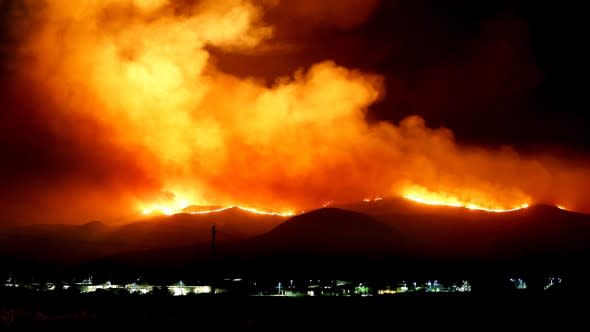When a wildfire is 100-percent 'contained,' does that mean the blaze is completely extinguished?
As wildfires rage and threaten to destroy everything in their paths, we often hear that they are "contained" by a certain percentage as firefighters continue making progress with battling the blazes.
As the percentage steadily increases from 30-, 60-, 90- and eventually up to 100-percent containment, it may seem like the hard work of emergency responders is complete and the wildfire is extinguished.
However, that's not the case, as there's a significant difference between containing and controlling a wildfire.

Containing a wildfire means that a fuel break, which may include natural barriers or a manually and/or a mechanically constructed line, around the fire has been completed, according to the National Park Service.
"It's a removal of all natural vegetation right around the perimeter of the fire so that it doesn't spread," said Kirk Schmitt, senior fire investigator and wildland fire specialist for EFI Global at Sedgwick, a full-service engineering, fire investigation, environmental, health and safety and specialty consulting services firm.
"Oftentimes, we'll use roads as containment, or we might use lakes or big, rocky outcropping," Schmitt said.
Bulldozer operators also assist in working to containing fires.
"They use roughly 10-foot (3-meter) blades to push aside shrubs, brush, grass and even trees so the advancing flames meet bare dirt and have nothing to consume," according to Fox News.
When a fire is 100-percent contained, this means that firefighters have managed to get a line completely around its perimeter.
"It can be a little confusing, because even though a fire is 100-percent contained, we still may have active fires burning inside that containment," Schmitt explained, noting that even with a 100-percent contained wildfire, you might drive down the road and still see lots of smoke from the active fires inside the line.
"For instance, when Yellowstone burned in the 1980s, the fire started in the summertime and burned into October," Schmitt said. "It then had snow laid down on it, and the next spring when the snow started coming up, we started having fires again because of deep-seated fires that continued to smolder."
It is possible for a wildfire to jump a containment line, yet it is a rare occurrence.
Although spots of fire may still be burning inside of the perimeter, firefighters are less concerned at this point about the spread of the fire and more focused on getting it under control, according to Schmitt.
To control a fire, the National Park Service stated, means to extinguish the blaze completely, including spot fires. When a wildfire is controlled, the fire line has been strengthened so that flareups from within the fire's perimeter won't break through the line.
A wildfire can smolder for months, which makes it hard to define when it is totally extinguished, according to Schmitt.
"We really don't track that information because it is extremely difficult to gauge," he said. "There is no hard data on when a fire is all the way out."
"What happens is that it gets to a point where all the federal and state firefighters leave and go back to their respected jobs, and then local resources will continue patrolling the area," he added.
